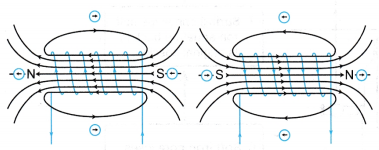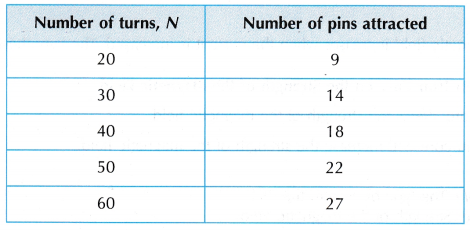What factors affect the strength of an electromagnet?
Factors Affecting the Strength of the Magnetic Field of an Electromagnet:
Factors that affect the strength of electromagnets are the nature of the core material, strength of the current passing through the core, the number of turns of wire on the core and the shape and size of the core.
How can we increase or decrease the strength of an electromagnet?
- The strength of the magnetic field of an electromagnet increases when:
(a) The current is increased
(b) The number of turns is increased
(c) The turns of wire are pushed closer together so that the length of the solenoid becomes shorter
(d) A soft iron core is placed into the solenoid - The use of alloys such as aluminium-nickel- cobalt (alnico) can produce stronger magnetic fields.
- The polarity at the ends of the solenoid is changed by changing the direction of the current, as shown in Figure. The direction of the magnetic field at any point can be shown by a plotting compass.

People also ask
- What is magnetic force on a current carrying conductor?
- Factors Affecting the Magnitude of the Force on a Current-carrying Conductor
- How Does a Transformer Work?
- What is the Magnetic Field?
- What Is Magnetic Effect Of Electric Current?
- Oersted Experiment on Magnetic Effect of Current
- How do you Determine the Direction of the Magnetic Field?
- What is the Meaning of Magnetic Force?
- Who discovered the magnet?
- How does a magnet work?
- What are the Different Types of Magnets?
- Is an electromagnet a temporary or a permanent magnet?
- What is the use of magnet?
- How does an electric bell work using electromagnets?
Factors Affecting the Strength of an Electromagnet Experiment
Problem: Some electric devices make use of very strong electromagnets while others need electromagnets that produce weaker magnetic fields. What are the factors that affect the strength of the magnetic field of an electromagnet?
A. What would be the effect of increasing the number of coils of wire in an electromagnet?
Aim: To study how the number of turns of the coil affect the strength of the magnetic field.
Inference: The number of turns of a solenoid affects the strength of the magnetic field.
Hypothesis: The larger the number of turns, the stronger the magnetic field.
Variables:
(a) Manipulated variable: Number of turns, N
(b) Responding variable: Strength of the magnetic field
(c) Fixed variables: The current in the solenoid, the type of core used, distance between the end of the soft iron rod and the pins in the Petri dish
Operational Definition: The strength of the magnetic field produced by the solenoid is operationally defined as the number of pins that can be attracted to one end of the core.
Materials: A box of pins, soft iron rod, insulated copper wire, connecting wires
Apparatus: D.C. power supply, ammeter, rheostat, Petri dish, retort stand with clamp
Method:
- The apparatus is set up as shown in Figure, with 20 turns of wire round the soft iron rod.
- The power supply is switched on and the number of pins attracted to the soft iron rod is counted.
- The power supply is switched off to let the pins fall back into the Petri dish.
- Steps 2 and 3 are repeated for coils with number of turns, N = 30, 40, 50 and 60.
Results: Discussion:
Discussion:
- The number of pins attracted to the soft iron rod increases as the number of turns of the coil is increased.
- When the current is switched off, the pins dropped back into the Petri dish because the soft iron rod cannot retain its magnetism.
Conclusion:
The strength of the magnetic field increases when the number of turns is increased.
B. How the size of the current carried by the coil affects the strength of the magnetic field?
Aim: To study how the size of the current carried by the coil affects the strength of the magnetic field.
Inference: The current in a coil affects the strength of the magnetic field.
Hypothesis: The larger the current in the coil, the stronger the magnetic field.
Variables:
(a) Manipulated variable: Current, I
(b) Responding variable: Strength of the magnetic field
(c) Fixed variables: The number of turns of the coil, the type of core used, distance between the end of the soft iron rod and the pins in the Petri dish
Operational Definition: The strength of the magnetic field produced by the solenoid is operationally defined as the number of pins that can be attracted to one end of the core.
Materials: A box of pins, soft iron rod, insulated copper wire, connecting wires
Apparatus: D.C. power supply, ammeter, rheostat, Petri dish, retort stand with clamp
Method:
- The same apparatus set-up as shown in above Figure is used.
- The power supply is switched on. The rheostat is adjusted to obtain a current, I = 0.5 A.
- The number of pins attracted to the soft iron rod is counted.
- The power supply is switched off to let the pins fall back into the Petri dish.
- Steps 2 to 5 are repeated for the values of current, I = 1.0 A, 1.5 A, 2.0 A, 2.5 A and 3.0 A.
Results: Discussion:
Discussion:
The number of pins attracted to the soft iron rod increases as current in the coil is increased.
Conclusion:
The strength of the magnetic field increases when the current is increased. The hypothesis is accepted.
C. How the use of a soft iron core affects the strength of the magnetic field?
Aim: To study how the use of a soft iron core affects the strength of the magnetic field.
Inference: A soft iron core affects the strength of the magnetic field.
Hypothesis: The soft iron core will increase the strength of the magnetic field.
Variables:
(a) Manipulated variable: The type of core in the coil
(b) Responding variable: Strength of the magnetic field
(c) Fixed variables: The current in the coil, the number of turns of the coil, distance between the end of the soft iron rod and the pins in the Petri dish
Operational Definition: The strength of the magnetic field produced by the solenoid is operationally defined as the number of pins that can be attracted to one end of the core.
Materials: A box of pins, insulated copper wire, 10 cm long iron rod, 10 cm long wooden rod, connecting wires
Apparatus: D.C. power supply, ammeter, rheostat, Petri dish, retort stand with clamp
Method:
- The same apparatus set-up as shown in above Figure is used with a coil wound round the wooden rod.
- The power supply is switched on. The rheostat is adjusted to obtain a current, I = 2.0 A.
- The number of pins attracted to the wooden rod is counted.
- The power supply is switched off to let the pins fall back into the Petri dish.
- The wooden rod is replaced by the soft iron rod and steps 2 to 4 are repeated.
Results: Discussion:
Discussion:
- The number of pins attracted by the coil with the soft iron rod is significantly more than the coil with the wooden rod.
- The soft iron rod concentrates the magnetic lines to produce a stronger magnetic field.
Conclusion:
The coil with the soft iron core produces a stronger magnetic field.
